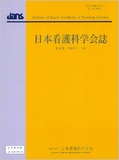Japanese
English
- 販売していません
- Abstract 文献概要
- 参考文献 Reference
要旨
目的:病院に勤務する女性看護師の腰痛・肩こりとワーク・ファミリー・コンフリクト(WFC)および職業性ストレスの関連を明らかにする.
方法:病院に勤務する女性看護師118名に,基本的属性,腰痛・肩こりの程度(0〜10点のNumerical Rating Scale;NRS),WFC尺度日本語版,新職業性ストレス簡易調査票を用いて調査した.分析では,腰痛・肩こりのNRS得点7点以上を高度群,7点未満を非高度群として2群に分け,単変量解析で有意となった項目を説明変数,腰痛または肩こりの程度を目的変数として多重ロジスティック回帰分析を実施した.
結果:腰痛には「時間に基づく仕事から家庭への葛藤(WIF)」と「役割明確さ」が有意に関連し,肩こりには「時間に基づくWIF」が有意に関連した.
結論:女性看護師の腰痛・肩こり対策には,WFCへの対策を個人と組織とが双方で行うことや,個人が責任を過度に負わない職場の協力体制を構築することが重要であると示唆された.
Aim: This study examines the association of work-family conflict (WFC) and job stress with back pain and neck and shoulder pain (katakori) among female nurses working in a hospital.
Method: We surveyed 118 female nurses working in the hospital considering their demographic characteristics, level of back pain and katakori, and their scores on the Japanese version of the WFC scale and the new brief job stress questionnaire. They were also asked to rate their back pain or katakori on a 0-10 point Numerical Rating Scale (NRS). For the analysis, participants were first divided into two groups: a high-level group with an NRS score of 7 or more points for back pain and katakori and a non-high-level group with an NRS score of fewer than 7 points. Next, multiple logistic regression analysis was conducted using the items that were significant in the univariate analysis as explanatory variables and the level of back pain or katakori as objective variables.
Results: Back pain was independently and significantly associated with “time-based work interference with family (WIF)” (OR: 1.26, 95% CI: 1.00-1.58, p = .047) and “role clarity” (OR: 3.94, 95% CI: 1.28-12.14, p = .017). Katakori was independently and significantly associated with “time-based WIF” (OR: 1.30, 95% CI: 1.07-1.59, p = .009).
Conclusions: The results suggest that WFC measures by both individuals and employers and the establishment of a workplace support system in which individuals are not overly responsible are important in addressing back pain and katakori among female nurses.
Copyright © 2022, Japan Academy of Nursing Science. All rights reserved.


